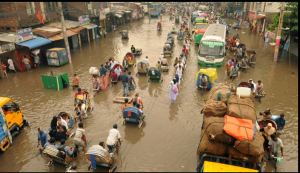Meraz Mostafa
It’s getting close to November, which means delegates to the UN climate talks will once gather to discuss climate change: This time in Marrakesh, Morocco.
This will be the first UN climate conference since countries agreed to the historic Paris Agreement last year, the first ever truly international climate change treaty.And while the agreement was well-worth celebrating — particularly, in getting so many countries with different interests to come together and agree to something — it is now important we continue the momentum that was built in Paris and turn our eyes to Marrakesh.
After all, the Paris Agreement will only remain historic if countries not only follow through on their voluntarily pledges to reduce carbon emissions, but also enhance those pledges. Otherwise, we will have no chance of keeping average global temperatures to the 1.5°C above pre-industrial levels, necessary to the survival of many.
Even though the Paris Agreement calls to limit temperature rise to well-below 2°C, with an ambitious goal of 1.5°C, many climate experts believe we cannot afford the half degree difference, as explained in a recent Daily Star column.
Studies prepared for the World Bank, by Climate Analytics and the Potsdam Institute for Climate Impact Research, found that a half degree difference could lead to significantly more dangerous weather events and disasters than previously thought.
“While 2°C as a long-term goal is safe for many countries and many peoples,” explained Dr. Saleemul Huq, director of the International Centre for Climate Change and Development, at the Paris conference last year, “it is not safe for all countries and all peoples.” The half a degree difference means about a 100 million people will “fall between the cracks.”
Currently, the planet is a little over 1°C warmer than pre-industrial levels, as shown by this widely-shared spiral:
If that isn’t worrisome, a paper published in the peer-reviewed scientific journal Nature in June of this year predicts that if current climate pledges are not improved in the next decade and a half, we are set to face a temperature rise from anywhere between 2.6°C to 3.1°C by 2100.
This will be devastating for Bangladesh, a country we all know is highly at risk of climate change. Not only is it located in a low-lying delta, putting it in danger of both sea-level rise from downstream and glaciers melting upstream (though the latter will be affected in part by India’s dams and proposed interlocking river project), but the country is also densely populated and many of its citizens poor.
The Fifth Assessment Report published by the Intergovernmental Panel on Climate Change a few years ago, lists the following climate threats for the country:
Flooding, droughts, storm surges, health hazards including cholera and heat stress, more frequent cyclones, heavier rain and generally unpredictable weather conditions.
These in turn will threaten Bangladesh’s food security and its economy, both of which have improved greatly in the last few decades.
And we should not forget that the impacts of climate change — and the difference between 1.5°C and 2°C — is about people: The people who will lose their homes, who will be forced to move away from their homelands, who find themselves living in fragile city slums in Bangladesh.
I had the chance to visit Rickshaw Garage slum earlier this year, located in the coastal city of Khulna in southwest Bangladesh. Named after the many rickshaws parked in the middle of the informal settlement, the slum is home to climate migrants whose homes were ruined after either cyclone Sidr and cyclone Aila struck in 2007 and 2009, respectively.
Informal settlements like this are only set to increase as climate change worsens. The capital city, Dhaka, will particularly face the burden of migrants with currently over half a million new people arriving each year, according to a World Bank study.
And it is not just Bangladesh. Low-lying small islands, whether in the Caribbean or the Pacific, will suffer too. For several of them, the question of 1.5 or 2 degrees is existential: It will be the difference of existing as island nations in the future or not existing at all.
This is why many from the small islands are chanting “1.5 to survive.”
The UN climate process began the year I was born. It took the majority of my life for nations to come together and agree to a treaty. But a treaty is only as good as those who adhere to it.
We now need to turn our attention to Marrakesh with the same vigor we did Paris.
Otherwise, we risk losing the great momentum already built. Vulnerable countries like Bangladesh are playing their part to adapt to climate change; it’s time high emitting nations played theirs and reduced emissions. This is why we we need pressure governments to not only deepen their pledges, but also implement them.
Let’s make sure that the aspiration goal of 1.5°C is not just an empty gesture in the Paris Agreement. Let’s make it a reality.
(The writer works at the International Centre for Climate Change and Development (ICCCAD), based at the Independent University, Bangladesh (IUB).)




